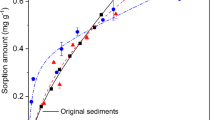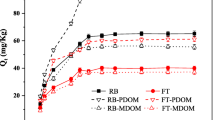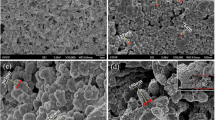Abstract
Sediment, consisting of different aggregation fractions, is a hotspot site for transport and transformation of various pollutants including antibiotics. However, the fate of different antibiotics in aquatic sediments mediated by sediment aggregation fraction adsorption and the mechanism behinds are still unclear. In this study, we investigated the adsorption behavior of two fluoroquinolone antibiotics (ciprofloxacin and ofloxacin) on four aggregation fractions separated from the sediment of Taihu Lake, a typical lake contaminated by antibiotics in China. The results showed that the adsorption of ciprofloxacin and ofloxacin fitted the Freundlich model, irrespective of sediment aggregation size. The adsorption of ciprofloxacin and ofloxacin was depended on the size of sediment aggregation fractions, and the macroaggregation (> 200 μm) exhibited the strongest capacity, followed by large microaggregation (63–200 μm), medium microaggregation (20–63 μm), and small and primary microaggregation (< 20 μm). This fraction size-dependent effects of sediment aggregations on antibiotic adsorption might be closely related to the differences in their specific surface areas, organic matter contents, and surface functional groups. The adsorption of ciprofloxacin and ofloxacin by sediment aggregation fractions was characterized by a combination of chemical and physical adsorptions, with the former being the dominant process. Compared with ofloxacin, ciprofloxacin could be more rapidly and easily absorbed by four sediment aggregation fractions, and more readily complexed with carboxyl groups on macroaggregation surface. The adsorption of two antibiotics by extracellular polymeric substance showed that tryptophan and tyrosine protein-like, humic-like substance on the surface of sediment could bind to both antibiotics through a complexation reaction. The π-π electron donor–acceptor interaction and hydrogen bonds were responsible for the antibiotic adsorption by sediment aggregation.
Graphical Abstract








Similar content being viewed by others
Data availability
Not applicable.
References
Aga DS, Lenczewski M, Snow D, Muurinen J, Sallach JB, Wallace JS (2016) Challenges in the measurement of antibiotics and in evaluating their impacts in agroecosystems: a critical review. J Environ Qual 45(2):407–419
Aljeboree AM, Alshirifi AN, Alkaim AF (2017) Kinetics and equilibrium study for the adsorption of textile dyes on coconut shell activated carbon. Arab J Chem 10:S3381–S3393
Almeida A, Duarte S, Nunes R, Rocha H, Pena A, Meisel L (2014) Human and veterinary antibiotics used in Portugal-a ranking for ecosurveillance. Toxics 2(2):188–225
Anggraini M, Kurniawan A, Ong LK, Martin MA, Liu JC, Soetaredjo FE, ... Ismadji S (2014) Antibiotic detoxification from synthetic and real effluents using a novel MTAB surfactant-montmorillonite (organoclay) sorbent. RSC Adv 4(31), 16298-16311
Arshadi M, Eskandarloo H, KarimiAbdolmaleki M, Abbaspourrad A (2018) A biocompatible nanodendrimer for efficient adsorption and reduction of Hg(II). Acs Sustain Chem Eng 6(10):13332–13348
Bai L, Zhao Z, Wang C, Wang C, Liu X, Jiang H (2017) Multi-spectroscopic investigation on the complexation of tetracycline with dissolved organic matter derived from algae and macrophyte. Chemosphere 187:421–429
Binh VN, Dang N, Anh NTK, Le XK, Thai PK (2018) Antibiotics in the aquatic environment of vietnam: sources, concentrations, risk and control strategy. Chemosphere 197:438–450
Carrales-Alvarado DH, Ocampo-Pérez R, Leyva-Ramos R, Rivera-Utrilla J (2014) Removal of the antibiotic metronidazole by adsorption on various carbon materials from aqueous phase. J Colloid Interf Sci 436:276–285
Cao E, Duan W, Wang A, Zheng Y (2017) Oriented growth of poly (m-phenylenediamine) on Calotropis gigantea fiber for rapid adsorption of ciprofloxacin. Chemosphere 171:223–230
Chen J, Wang P, Wang C, Wang X, Miao L, Liu S, Yuan Q, Sun S (2020) Fungal community demonstrates stronger dispersal limitation and less network connectivity than bacterial community in sediments along a large river. Environ Microbiol 22(3):832–849
Chen Y, Lin Y, Ho S, Zhou Y, Ren N (2018) Highly efficient adsorption of dyes by biochar derived from pigments-extracted macroalgae pyrolyzed at different temperature. Bioresource Technol 259:104–110
Conde-Cid M, Ferreira-Coelho G, Núez-Delgado A, Fernández-Calvino D, Arias-Estévez M, Álvarez-Rodríguez E, Fernández -Sanjurjo MJ (2019) Competitive adsorption of tetracycline, oxytetracycline and chlortetracycline on soils with different pH value and organic matter content. Environ Res 178, 108669
Conkle JL, Lattao C, White JR, Cook RL (2010) Competitive sorption and desorption behavior for three fluoroquinolone antibiotics in a wastewater treatment wetland soil. Chemosphere 80(11):1353–1359
Dinh QT, Moreau-Guigon E, Pierre L, Fabrice A, Marie-Jeanne T, Martine B, Joelle E, Marc C (2017) Fate of antibiotics from hospital and domestic sources in a sewage network. Sci Total Environ 575:758–766
Dong D, Zhang L, Guo Z, Hua X (2017) The role of extracellular polymeric substances on the sorption of pentachlorophenol onto natural biofilms in different incubation times: a fluorescence study. Chem Ecol 33(2):131–142
Duan W, Li M, Xiao W, Wang N, Niu B, Zhou L, Zheng Y (2019) Enhanced adsorption of three fluoroquinolone antibiotics using polypyrrole functionalized Calotropis gigantea fiber. Colloid Surface a 574:178–187
Fadário VMF, Dias M, Teixeira ACSC, Alves Palma MSA (2014) Environmental contamination by fluoroquinolones. Braz J Pharm Sci 50:41–54
Fan C, Zhang L, Qin B, Wang S, Hu W, Zhang C (2004) Estimation on dynamic release of phosphorus from wind-induced suspended particulate matter in Lake Taihu. Sci China Ser D 478:710–719
Fu Q, He J, Blaney L, Zhou D (2016) Roxarsone binding to soil-derived dissolved organic matter, insights from multi-spectroscopic techniques. Chemosphere 155:225–233
Gu C, Gao P, Yang F, An D, Munir M, Jia H, Xue G, Ma C (2017) Characterization of extracellular polymeric substances in biofilms under long-term exposure to ciprofloxacin antibiotic using fluorescence excitation-emission matrix and parallel factor analysis. Environ Sci Pollut Res 24(15):13536–13545
Guo Y, Qin P, Wang C, Pan X, Dong X, Zong W (2020) Characterization on the toxic mechanism of two fluoroquinolones to trypsin by spectroscopic and computational methods. J Environ Sci Heal b 55(3):230–238
Han S, Delgado-Baquerizo M, Luo X, Liu Y, Van Nostrand JD, Chen W, Zhou J, Huang Q (2021) Soil aggregate size-dependent relationships between microbial functional diversity and multifunctionality. Soil Biol Biochem 154:108143
Hanamoto S, Nakada N, Jürgens MD, Johnson AC, Yamashita N, Tanaka H (2018) The different fate of antibiotics in the Thames River, UK, and the Katsura River. Japan Environ Sci Pollut Res 25(2):1903–1913
Hu Y, Pan C, Zheng X, Liu S, Hu F, Xu L ... Peng X (2020) Removal of ciprofloxacin with aluminum-pillared kaolin sodium alginate beads (CA-Al-KABs): Kinetics, isotherms, and BBD model. Water 12(3), 905
Huang M, Li Z, Huang B, Luo N, Zhang Q, Zhai X, Zeng G (2018) Investigating binding characteristics of cadmium and copper to DOM derived from compost and rice straw using EEM-PARAFAC combined with two-dimensional FTIR correlation analyses. J Hazard Mater 344:539–548
Huang Y, Wang Y, Huang Y, Zhang L, Ye F, Wang J, Shang J, Liao Q (2020) Impact of sediment characteristics on adsorption behavior of typical antibiotics in Lake Taihu. China Sci Total Environ 718:137329
Jing XR, Wang YY, Liu WJ, Wang YK, Jiang H (2014) Enhanced adsorption performance of tetracycline in aqueous solutions by methanol-modified biochar. Chem Eng J 248:168–174
Klein EY, Van Boeckel TP, Martinez EM, Pant S, Gandra S, Levin SA, Goossens H, Laxminarayan R (2018) Global increase and geographic convergence in antibiotic consumption between 2000 and 2015. Proc Natl Acad Sci USA 115(15):E3463–E3470
Kovalakova P, Cizmas L, McDonald TJ, Marsalek B, Feng M, Sharma VK (2020) Occurrence and toxicity of antibiotics in the aquatic environment: a review. Chemosphere 251:126351
Li J, Sabourin L, Renaud J, Halloran S, Singh A, Sumarah M, Dagnew M, Ray MB (2021a) Simultaneous quantification of five pharmaceuticals and personal care products in biosolids and their fate in thermo-alkaline treatment. J Environ Manage 278:111404
Li L, Zhao X, Liu D, Song K, Liu Q, He Y (2021b) Occurrence and ecological risk assessment of PPCPs in typical inflow rivers of Taihu lake. China J Environ Manage 285:112176
Li J, Liao L, Jia Y, Tian T, Gao S, Zhang C, ... Wang Z (2022) Magnetic Fe3O4/ZIF-8 optimization by Box-Behnken design and its Cd (II)-adsorption properties and mechanism. Arab. J. Chem. 15(10), 104119
Li S, Ju H, Ji M, Zhang J, Song K, Chen P, Mu G (2018a) Terrestrial humic-like fluorescence peak of chromophoric dissolved organic matter as a new potential indicator tracing the antibiotics in typical polluted watershed. J Environ Manage 228:65–76
Li S, Shi W, Liu W, Li H, Zhang W, Hu J, Ke Y, Sun W, Ni J (2018b) A duodecennial national synthesis of antibiotics in China’s major rivers and seas (2005–2016). Sci Total Environ 615:906–917
Li X, Zhou X, Mu J, Lu L, Han D, Lu C, Wang M (2011) Thermodynamics and kinetics of p-aminophenol adsorption on poly (aryl ether ketone) containing pendant carboxyl groups. J Chem Eng Data 56(11):4274–4277
Li Y, Zhang Y, Li Z, Wan J, Dang C, Fu J (2021c) Characterization of colored dissolved organic matter in the northeastern South China Sea using EEMs-PARAFAC and absorption spectroscopy. J Sea Res 180:102159
Li Z, Li M, Zhang Z, Li P, Zang Y, Liu X (2020) Antibiotics in aquatic environments of China: a review and meta-analysis. Ecotox Environ Safe 199(11):110668
Luo Y, Chen J, Wu C, Zhang J, Tang J, Shang J, Liao Q (2019) Effect of particle size on adsorption of norfloxacin and tetracycline onto suspended particulate matter in lake. Environ Pollut 244:549–559
Maged A, Kharbish S, Ismael IS, Bhatnagar A (2020) Characterization of activated bentonite clay mineral and the mechanisms underlying its sorption for ciprofloxacin from aqueous solution. Environ Sci Pollut Res 27(26):32980–32997
Mansouri H, Carmona RJ, Gomis-Berenguer A, Souissi-Najar S, Ouederni A, Ania CO (2015) Competitive adsorption of ibuprofen and amoxicillin mixtures from aqueous solution on activated carbons. J Colloid Interf Sci 449:252–260
Marttila H, Kløve B (2015) Spatial and temporal variation in particle size and particulate organic matter content in suspended particulate matter from peatland-dominated catchments in Finland. Hydrol Process 29(6):1069–1079
Miao L, Wang C, Hou J, Wang P, Ao Y, Li Y, Yao Y, Lv B, Yang Y, You G, Xu Y, Gu Q (2017) Response of wastewater biofilm to CuO nanoparticle exposure in terms of extracellular polymeric substances and microbial community structure. Sci Total Environ 579:588–597
Murphy KR, Stedmon CA, Wenig P, Bro R (2014) OpenFluor-an online spectral library of auto-fluorescence by organic compounds in the environment. Anal Methods-UK 6(3):658–661
Parente CET, Brito EMS, Azeredo A, Meire RO, Malm O (2019) Fluoroquinolone antibiotics and their interactions in agricultural soils-a review. Orbital 11(1):42–52
Pezoti Jr O, Cazetta AL, Souza IP, Bedin KC, Martins AC, Silva TL, Almeida VC (2014) Adsorption studies of methylene blue onto ZnCl2-activated carbon produced from buriti shells (Mauritia flexuosa L.). J Ind Eng Chem 20(6), 4401–4407
Peng X, Hu F, Lam FL, Wang Y, Liu Z, Dai H (2015) Adsorption behavior and mechanisms of ciprofloxacin from aqueous solution by ordered mesoporous carbon and bamboo-based carbon. J Colloid Interf Sci 460:349–360
Philip JM, Aravind UK, Aravindakumar CT (2018) Emerging contaminants in Indian environmental matrices-a review. Chemosphere 190:307–326
Qi Y, Zhang TC, Ren Y (2014) Testosterone sorption and desorption: effects of soil particle size. J Hazard Mater 279, 493-501
Rath S, Fostier AH, Pereira LA, Dioniso AC, Ferreira FD, Doretto KM, Peruchi LM, Viera A, Neto OFD, Dal Bosco SM, Martínez-Mejía MJ (2019) Sorption behaviors of antimicrobial and antiparasitic veterinary drugs on subtropical soils. Chemosphere 214:111–122
Sangster JL, Oke H, Zhang Y, Bartelt-Hunt SL (2015) The effect of particle size on sorption of estrogens, androgens and progestagens in aquatic sediment. J Hazard Mater 299:112–121
Scherr FF, Sarmah AK, Di HJ, Cameron KC (2009) Sorption of estrone and estrone-3-sulfate from CaCl2 solution and artificial urine in pastoral soils of New Zealand. Environ Toxicol Chem 28(12):2564–2571
Shen S, Yang S, Jiang Q, Luo M, Li Y, Yang C, Zhang D (2020) Effect of dissolved organic matter on adsorption of sediments to Oxytetracycline: an insight from zeta potential and DLVO theory. Environ Sci Pollut Res 27(2):1697–1709
Siebers N, Abdelrahman H, Krause L, Amelung W (2018) Bias in aggregate geometry and properties after disintegration and drying procedures. Geoderma 313:163–171
Siedlewicz G, Bialk-Bielinska A, Borecka M, Winogradow A, Stepnowski P, Pazdro K (2018) Presence, concentrations and risk assessment of selected antibiotic residues in sediments and near-bottom waters collected from the Polish coastal zone in the southern Baltic Sea - Summary of 3 years of studies. Mar Pollut Bull 129(2):787–801
Singh V, Srivastava VC (2020) Self-engineered iron oxide nanoparticle incorporated on mesoporous biochar derived from textile mill sludge for the removal of an emerging pharmaceutical pollutant. Environ Pollut 259:113822
Six J, Elliott ET, Paustian K, Doran JW (1998) Aggregation and soil organic matter accumulation in cultivated and native grassland soils. Soil Sci Soc Am J 62(5):1367–1377
Soltani R, Dinari M, Mohammadnezhad G (2018) Ultrasonic-assisted synthesis of novel nanocomposite of poly(vinyl alcohol) and amino-modified MCM-41: a green adsorbent for Cd(II) removal. Ultrason Sonochem 40:533–542
Stedmon CA, Bro R (2008) Characterizing dissolved organic matter fluorescence with parallel factor analysis: a tutorial. Limnol Oceanogr Meth 6(11):572–579
Tang J, Wang S, Fan J, Long S, Wang L, Tang C, Tam NF, Yang Y (2019) Predicting distribution coefficients for antibiotics in a river water-sediment using quantitative models based on their spatiotemporal variations. Sci Total Environ 655:1301–1310
Tan F, Sun D, Gao J, Zhao Q, Wang X, Teng F ... Chen J (2013) Preparation of molecularly imprinted polymer nanoparticles for selective removal of fluoroquinolone antibiotics in aqueous solution. J Hazard Mater 244, 750-757
Wang H, Hu C, Shen Y, Shi B, Zhao D, Xing X (2019) Response of microorganisms in biofilm to sulfadiazine and ciprofloxacin in drinking water distribution systems. Chemosphere 218:197–204
Wicke D, Böckelmann U, Reemtsma T (2008) Environmental influences on the partitioning and diffusion of hydrophobic organic contaminants in microbial biofilms. Environ Sci Technol 42(6):1990–1996
Williams CJ, Yamashita Y, Wilson HF, Jaffé R, Xenopoulos MA (2010) Unraveling the role of land use and microbial activity in shaping dissolved organic matter characteristics in stream ecosystems. Limnol Oceanogr 55(3):1159–1171
Wu W, Zhou D (2019) Influence of biochar aging on its physicochemical properties and adsorption of heavy metals. J Agro-Environ Sci 38(1):7–13
Xiong C, Xue C, Huang L, Hu P, Fan P, Wang S, Zhou X, Yang Z, Wang Y, Ji H (2021) Enhanced selective removal of Pb(II) by modification low-cost bio-sorbent: experiment and theoretical calculations. J Clean Prod 316:128372
Xu J, Sheng G, Ma Y, Wang L, Yu H (2013) Roles of extracellular polymeric substances (EPS) in the migration and removal of sulfamethazine in activated sludge system. Water Res 47(14):5298–5306
Xu J, Zhang Y, Zhou C, Guo C, Wang D, Du P, Luo Y, Wan J, Meng W (2014) Distribution, sources and composition of antibiotics in sediment, overlying water and pore water from Taihu Lake, China. Sci Total Environ 497:267–273
Yamashita Y, Kloeppel BD, Knoepp J, Zausen GL, Jaffé R (2011) Effects of watershed history on dissolved organic matter characteristics in headwater streams. Ecosystems 14(7):1110–1122
Yang J, Huang Y, Chen Y, Hassan M, Zhang X, Zhang B, Gin KYH, He Y (2020) Multi-phase distribution, spatiotemporal variation and risk assessment of antibiotics in a typical urban-rural watershed. Ecotox Environ Safe 206:111156
Yang L, Xiao S, Luan T, Tam NF (2018) Overproduction of microbial extracellular polymeric substances in subtropical intertidal sediments in response to endocrine disrupting chemicals. Sci Total Environ 624:673–682
Yu K, Sun C, Zhang B, Hassan M, He Y (2019) Size-dependent adsorption of antibiotics onto nanoparticles in a field-scale wastewater treatment plant. Environ Pollut 248:1079–1087
Zhang L, Dong D, Hua X, Guo Z (2018) Inhibitory effects of extracellular polymeric substances on ofloxacin sorption by natural biofilms. Sci Total Environ 625:178–184
Zhao J, Liang G, Zhang X, Cai X, Li R, Xie X, Wang Z (2019) Coating magnetic biochar with humic acid for high efficient removal of fluoroquinolone antibiotics in water. Sci Total Environ 688:1205–1215
Zhao T, Li X, Ning Z, Zhao H, Zhang J, Zhao W (2018) Pore structure and adsorption behavior of shale gas reservoir with influence of maturity: a case study of Lower Silurian Longmaxi formation in China. Arab J Geosci 11(13):1–4
Zhao Y, Tan Y, Guo Y, Gu X, Wang X, Zhang Y (2013) Interactions of tetracycline with Cd (II), Cu (II) and Pb (II) and their cosorption behavior in soils. Environ Pollut 180:206–213
Zheng W, Zhao Z, Gong Q, Zhai B, Li Z (2018) Responses of fungal-bacterial community and network to organic inputs vary among different spatial habitats in soil. Soil Biol Biochem 125:54–63
Zhu Y, Bai Z, Wang B, Zhai L, Luo W (2017) Microfluidic synthesis of renewable biosorbent with highly comprehensive adsorption performance for copper (II). Front Chem Sci Eng 11(2):238–251
Funding
This work was supported by the National Natural Science Foundation of China (No. 52022028, No. 52279061) and the Key Program of National Natural Science Foundation of China (No. 92047201, No. 92047303).
Author information
Authors and Affiliations
Contributions
Conceptualization: Bo Zhang; Writing – original draft preparation: Bo Zhang; Formal analysis and investigation: Bo Zhang, Juan Chen; Writing—review and editing: Juan Chen; Funding acquisition: Juan Chen, Peifang Wang; Project administration: Juan Chen, Peifang Wang; Methodology: Chao Wang, Ge Cui; Software: Juan Chen, Jingjing Zhang; Supervision: Chao Wang; Data curation: Ge Cui; Validation: Yu Hu; Visualization: Han Gao.
Corresponding author
Ethics declarations
Ethical approval
Not applicable.
Consent to participate
Not applicable.
Consent for publication
Not applicable.
Competing interests
The authors declare no competing interests.
Additional information
Responsible Editor: Tito Roberto Cadaval Jr.
Publisher's note
Springer Nature remains neutral with regard to jurisdictional claims in published maps and institutional affiliations.
Highlights
• Antibiotics adsorption was depended on the size of sediment aggregation fractions.
• Sediment aggregation had a stronger affinity to ciprofloxacin than ofloxacin.
• Ciprofloxacin was complexed with carboxyl groups on macroaggregation surface.
• Antibiotics adsorption was by complexation, π-π electron interaction, and H bond.
Supplementary Information
Below is the link to the electronic supplementary material.
Rights and permissions
Springer Nature or its licensor (e.g. a society or other partner) holds exclusive rights to this article under a publishing agreement with the author(s) or other rightsholder(s); author self-archiving of the accepted manuscript version of this article is solely governed by the terms of such publishing agreement and applicable law.
About this article
Cite this article
Zhang, B., Chen, J., Wang, C. et al. Insight into different adsorption behaviors of two fluoroquinolone antibiotics by sediment aggregation fractions. Environ Sci Pollut Res 30, 24329–24343 (2023). https://doi.org/10.1007/s11356-022-23947-0
Received:
Accepted:
Published:
Issue Date:
DOI: https://doi.org/10.1007/s11356-022-23947-0




